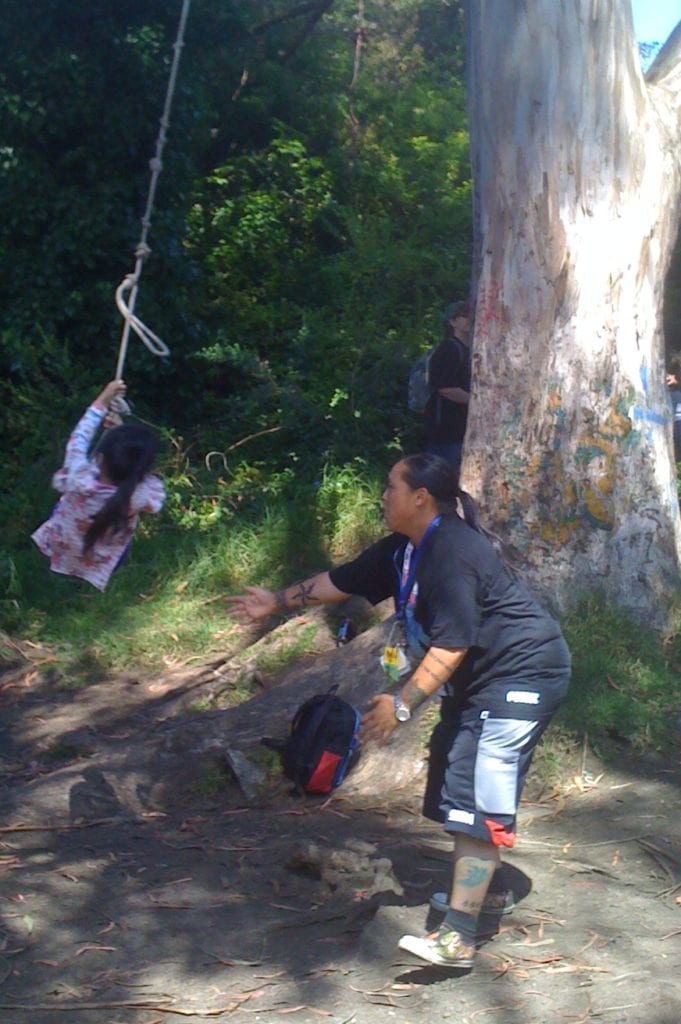By Murray Schneider, Glen Canyon correspondent
It was a good morning for day-trippers who walked the Glen Canyon trail, the one that begins below the Turquoise Way steps.
It wasn’t such a great day for Algerian ivy that encroaches Medusa-like along the same trail, its tendrils prone to snaking out and hindering hikers.
“We’re here to cut it back,” announced Chris Campbell, a Recreation and Parks Natural Habitat gardener. “It’ll make the trail easier for people to use.”
Campbell, who has been with the Natural Areas Program since 1996, spoke to attentive volunteers from Friends of Glen Park Canyon Park. Both volunteers and City gardener, Jenny Sotelo, had earlier carried tools from the canyon floor to slopes adjacent to Diamond Heights.
Campbell pointed to a clump of overarching willow branches encroaching over the trail.
He retrieved a lopper and demonstrated its use. “We want to make good cuts,” he said. He pruned along a junction where a gnarled willow limb angled at 45-degrees. “This way it’ll grow back straight and won’t impede walkers.”
As if on cue, a couple descended along the path. Gesturing to his volunteers, Campbell said, “Your neighbors at work.” The man corrected Campbell. “We’re from Monterey. We’re visiting.” As they passed, the women said, “Thank you, though.
The work party let them pass.
A volunteer called after them, “Support KPIG!” a reference to a community radio station out of Santa Cruz. Looking over her shoulder, the women grinned. “We listen all the time. It’s our favorite.”
Not to be undone, Campbell said, “This is one of my favorite open places in San Francisco.”

The volunteers and their supervisors trooped along, clipping back invasive Himalayan blackberry and tossing its thorny stalks into a compost heap several feet in the shrubbery. They approached a thicket of ivy, its interlocking roots tangled in an impenetrable hydra of jig sawed brown twigs.

“Algerian ivy is invasive,” said Campbell, stating the obvious. “It’s been known to smother trees and topple them.” He pointed to a low-lying clump that poached along the trail, gerrymandering its way towards the trail edge. “We’ll use the cultivators, Jenny,” he said. “Steve, can you clip while we pull.”
Campbell and Sotelo stabbed the underbelly of the ivy with their three-pronged rakes, hauling it back while Steven Uchida, a retired postal worker, made repeated cuts with his hedge shears. “Be care of our fingers,” Campbell said.
The work completed, Campbell observed the scene. “The birds will love it, they’ll eat ‘til their heart’s content,” he said. “It’s loaded with bugs.”
The Rec and Park Natural Areas Program was started the year before Chris Campbell donned his first pair of Carhartt dungarees. It was inaugurated to ensure that San Francisco’s natural spaces such as Mount Davidson and Twin Peaks, sisters to 70-acre Glen Canyon, would be cared for and tended. With Islais Creek meandering through it, the canyon is a riparian sanctuary for both domestic and migratory birds, as well as a respite for City walkers looking for a refuge from urban congestion and noise.
A train of Silver Tree summer campers and their counselors greeted Campbell, heading for a trail cut-off that would lead them to a rope swing dangling from a giant eucalyptus tree no more than a football field length away, but camouflaged by a pillow of tree tops.

The work party allowed them to pass and then continued along their way. Campbell stopped before a maze of coyote brush that trespassed along the trail. He maneuvered his lopper through the intruding branches, making sharp and true cuts along impinging limbs that obstructed foot traffic. “You want to make straight cuts,” he instructed.


